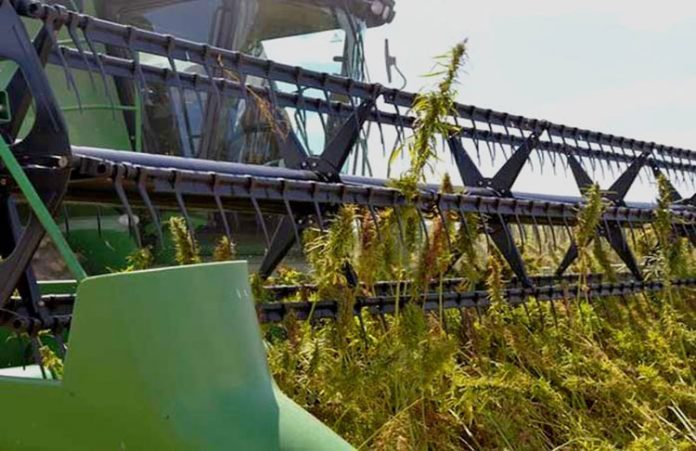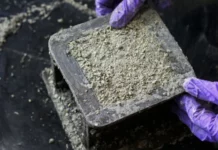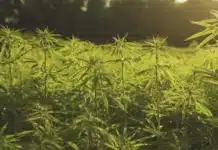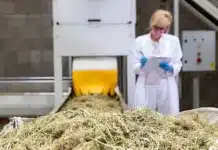With just over two weeks left to apply for a license and register to grow hemp in Wisconsin for the first time in more than half a century, state farmers must also factor in low traditional crop and dairy prices—and a possible trade war—when considering adding hemp to their field rotation and market sales.
Jerry Clark, agricultural agent for UW-Extension-Chippewa County, said the extension has been fielding questions about hemp farming possibilities since the Wisconsin State Legislature approved the farming in November, which was allowed through the Farm Bill in 2014.
This is the first year in recent decades farmers can grow hemp in the state. The deadline to apply for a license and register is May 1.
Growing hemp is an attractive option to farmers who have felt the impact of consistently low prices in dairy and traditional crops like corn and grain. But Clark added that the process of growing, harvesting and processing hemp is similar to other crop techniques, and farmers are always interested in furthering their market.
“This crop might be one that they can make some more income on,” Clark said.
Currently, hemp is grown predominantly for its seed, Clark said, but with a fiber market for hemp — which has been traditionally used for ropes, fabric and paper among other products — sales could flourish. That market would be unlike the current corn and other crop markets, which saw a good growing season with a low demand for the product, Clark said.
A possible 25 percent increase on Chinese soybean tariffs — and other tariff bartering as part of a possible trade war — could also impact profits for farmers in Chippewa County, Clark said.
“It’s at a global level, and how does that impact a farm in Chippewa County? It’s trickle-down there. The market reacts to all news,” Clark said.
China is the largest purchaser of American soybeans, but increases in price could lead the country elsewhere to find its crop.
As for those looking to hemp as another source of income to pad their market worries, the extension has been suggesting farmers parcel off one to two acres of their planting land for the hemp, rather than fully jumping into the hemp-growing business.
“Try it on a smaller scale. Maybe if (the) market expands, that’s where they can expand acreage… I don’t see it being adopted widely immediately,” Clark said, adding that the adoption of larger hemp growing farmers could come within three to five years, should the market pick up.
Farmers who apply for the license will also have to submit to research and tests of their fields and products, according to the Wisconsin Department of Agriculture, Trade and Consumer Protection (DATCP).
Growers will have to submit a planting report by July 1 or 30 days after planting – whichever is earliest – and a final product report by Dec. 15 of the crop year. Records will also have to be kept on a seed source, seed variety, agronomic and production information, fit-for-commerce certificates and the name and address of a processor, according to the DATCP.
Processors of hemp will have to report on the amount of hemp received from growers and markets by Dec. 15 and keep a record of its sources of industrial hemp and those the hemp is sold to.
“These first few years, it’s going to be more of a research and trial period in order for farmers to get comfortable growing it. It has lots of benefits in terms of helping with crop rotation, introducing a new crop in your cropping system for disease and pest management,” Clark said. “Hopefully we can get a few farmers to grow it this year and see how it goes.”
Growing hemp in the Chippewa Valley
Local farmers will want to get hemp into their fields just after soybean planting, Clark explained, provided the soil is warmer. Planting by late May to early June and harvesting by mid-September is ideal, Clark added.
Pest management is almost a non-factor, Clark said, while the fertility of the plant is similar to alfalfa and corn. The plant is also an aggressive species, making weed control an easily managed problem.
It has similarity to soybeans in terms of disease possibilities—farmers should not grow hemp in fields where soybeans were harvested the year prior. Clark recommended old corn or grain fields.
Growers won’t need to hassle with added equipment as well. Clark explained the crop can be planted with a traditional seeder and drill that most crop farmers have, can be harvested with a modern combine and its processing involves a similar drying and baling process like that of hay.
“That’s where I think farmers in this area would have some advantage, because they already have equipment,” Clark said.
All fields have to be tested by the DATCP for THC levels prior to harvesting, the department said. Belonging to the same family as the marijuana plant, THC is present in the hemp, though commonly very low.
Taken 30 days before harvesting, readings higher than 0.3 percent of THC will not be accepted, and farmers will have to destroy the field where a failed test was taken, eating the loss of planting. If the crop passes, growers will receive a fit-to commerce certificate.
According to DATCP, growers will not be prosecuted under Wisconsin law for THC levels that are under 1 percent.
Growers will also have to pay $250 per test and sample.
Farmers should also consider the high moisture levels of the plant, which could make timing a harvest tricky, particularly with the stems, Clark said.
Once harvested, hemp is dried and stored before it’s sold, Clark explained.
Obtaining permission and working through DATCP
Inspections, licensing fees and research proposals are all requirements those interested in hemp farming will have to contend with, according to DATCP.
Growers and processors will have to apply for a one-time license and annual registration through the department by May 1. Background checks are included this process, and those convicted with drug offenses are prohibited from growing hemp.
Growers registering 30 or less acres will have to pay $150 for a license, and the cost increases $5 per additional acre up to 199 acres. Those registering 200 acres or more will pay $1,000.
There is no fee for a processor license, but processor registration is $100 annually. Grower registration will cost $350.
Growers who will also process their own hemp do not need a processing license.
Once a grower is registered and licensed, they will be responsible for obtaining their own seeds. According to DATCP, the department is still in the process of obtaining registration through the U.S. Drug Enforcement Agency to be a seed importer.
Seed certification is not a requirement for distributors of hemp seed, DATCP explained, but it does provide increased chances of a low THC reading.
Farmers interested in selling seed in Wisconsin will need to become licensed through the DATCP as a seed labeler, according to the department.
For more information on Wisconsin’s first year back in hemp production, visit datcp.wi.gov.














